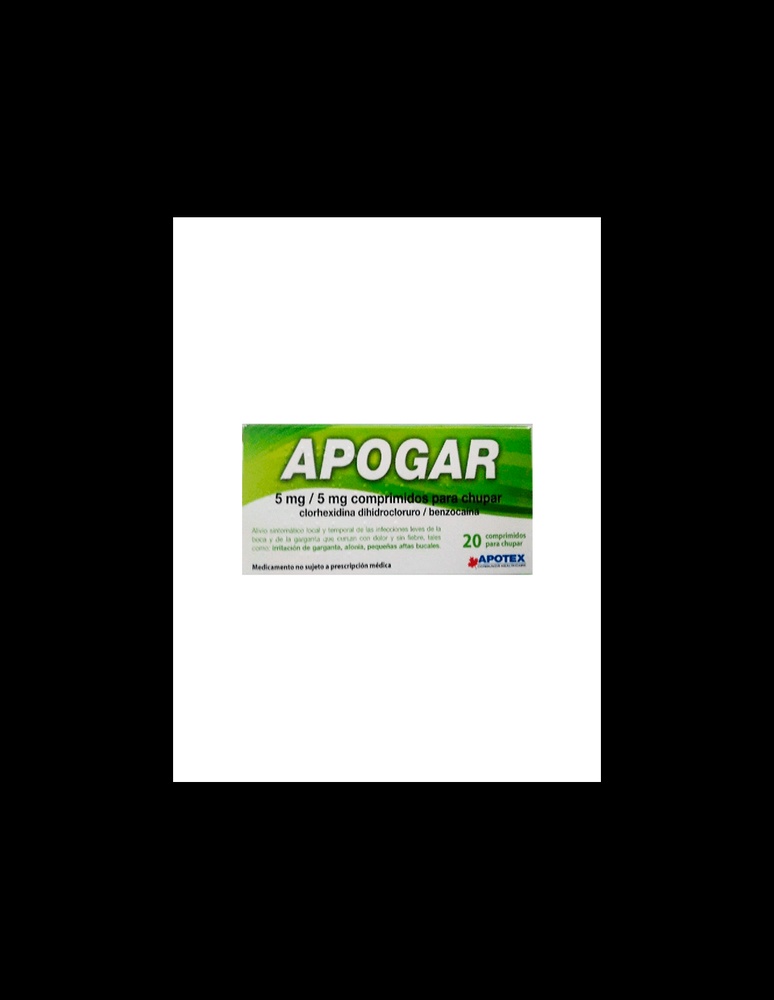

АПОГАР 5МГ/5МГ ТАБЛЕТКИ ДЛЯ РОЗСМАКТУВАННЯ

Запитайте лікаря про рецепт на АПОГАР 5МГ/5МГ ТАБЛЕТКИ ДЛЯ РОЗСМАКТУВАННЯ

Інструкція із застосування АПОГАР 5МГ/5МГ ТАБЛЕТКИ ДЛЯ РОЗСМАКТУВАННЯ
Вступ
Опис: інформація для користувача
Апогар 5 мг/5 мг таблетки для розсмоктування
Дигідрохлорид хлоргексидину/Бензокаїн
Прочитайте уважно весь опис перед тим, як почати приймати цей лікарський засіб, оскільки він містить важливу інформацію для вас.
Слідуйте точно інструкціям щодо застосування лікарського засобу, наведеним у цьому описі або вказаним вашим лікарем чи фармацевтом.
- Збережіть цей опис, оскільки вам може знадобитися знову його прочитати.
- Якщо вам потрібна порада або додаткова інформація, проконсультуйтеся з фармацевтом.
- Якщо ви відчуваєте побічні ефекти, проконсультуйтеся з лікарем або фармацевтом, навіть якщо це побічні ефекти, які не наведені в цьому описі.
- Вам слід проконсультуватися з лікарем, якщо ваш стан погіршується або не покращується після 2 днів.
Зміст опису
- Що таке Апогар і для чого він використовується
- Що вам потрібно знати перед тим, як почати приймати Апогар
- Як приймати Апогар
- Можливі побічні ефекти
- Зберігання Апогару
- Зміст упаковки та додаткова інформація
1. Що таке Апогар і для чого він використовується
Активні речовини цього лікарського засобу діють шляхом поєднання антисептичної та дезінфікуючої дії хлоргексидину з місцевою анестезуючою дією бензокаїну.
Цей лікарський засіб використовується для симптоматичного місцевого та тимчасового полегшення легких інфекцій ротової порожнини та горла, які супроводжуються больовими відчуттями, без гарячки, такими як: подразнення горла, афонія, маленькі афти в ротовій порожнині, починаючи з 6 років.
2. Що вам потрібно знати перед тим, як почати приймати Апогар
Не приймайте Апогар
- якщо ви алергічні на активні речовини або на будь-який інший компонент цього лікарського засобу, наведений у розділі 6.
А
Проконсультуйтеся з лікарем або фармацевтом перед тим, як почати приймати цей лікарський засіб:
- якщо ви не переносите інші місцеві анестетики, такі як пара-амінобензойна кислота (ПАБК), параабени або парафенілендіамін (компонент фарб для волосся),
- якщо ви пацієнт похилого віку або ваш імунологічний статус знижений, вам можуть знадобитися менші дози, у разі сумнівів проконсультуйтеся з лікарем,
- якщо у вас є важка або розлога травма в ротовій порожнині,
- якщо ви страждаєте на пародонтоз (хворобу ясен), оскільки хлоргексидин може спричинити збільшення надгігівальних зубних відкладень,
- рекомендується підтримувати належну гігієну ротової порожнини для зменшення накопичення зубного каменю та можливої забарвлення зубів, яке може спричинити хлоргексидин,
- не слід приймати дози, що перевищують рекомендовані у розділі 3. (Як приймати Апогар).
Вживання інших лікарських засобів
Повідомте лікаря або фармацевта, якщо ви приймаєте або нещодавно приймали інші лікарські засоби, навіть ті, які можна придбати без рецепта.
Хоча вони не описані у рекомендаціях щодо використання, не слід використовувати їх разом з іншими лікарськими засобами для місцевого застосування в ротовій порожнині без консультації з лікарем або фармацевтом.
Це особливо важливо у разі:
- Інших антисептиків для ротової порожнини або горла.
- Лікарських засобів, що інгібують холінестеразу (лікарські засоби для лікування хвороби Альцгеймера).
- Сульфамідів (використовуваних для лікування інфекцій).
Аніонні сполуки та суспензійні агенти, звичайні компоненти зубних паст, знижують ефективність хлоргексидину, тому слід ретельно промивати ротову порожнину після використання зубної пасти.
Вплив на діагностичні тести
Цей лікарський засіб може взаємодіяти з тестом на визначення функції підшлункової залози, який використовує бентіроміду. Не приймайте цей лікарський засіб至少 за три дні до проведення тесту та повідомте лікаря.
Діти та підлітки
Цей лікарський засіб слід застосовувати у дітей старших 6 років. Для форми застосування у дітей старших 6 років див. розділ 3.
Як приймати Апогар
Слід застосовувати з обережністю, оскільки може виникнути метгемоглобінемія (утруднення дихання, головокружіння, втома, слабкість).
Вживання Апогару з іншими лікарськими засобами
Повідомте лікаря або фармацевта, якщо ви приймаєте, нещодавно приймали або можете приймати інші лікарські засоби.
Хоча вони не описані у рекомендаціях щодо використання, не слід використовувати їх разом з іншими лікарськими засобами для місцевого застосування в ротовій порожнині без консультації з лікарем або фармацевтом.
Це особливо важливо у разі:
- Інших антисептиків (дезінфікуючих засобів) для ротової порожнини або горла.
- Лікарських засобів, що інгібують холінестеразу (лікарські засоби для лікування хвороби Альцгеймера).
- Сульфамідів (використовуваних для лікування інфекцій).
Аніонні сполуки та суспензійні агенти, звичайні компоненти зубних паст, знижують ефективність хлоргексидину, тому слід ретельно промивати ротову порожнину після використання зубної пасти.
Вагітність та лактація
Якщо ви вагітні, у період лактації, вважаєте, що можете бути вагітні або плануєте вагітність, проконсультуйтеся з лікарем або фармацевтом перед тим, як приймати цей лікарський засіб.
Вживання лікарських засобів під час вагітності може бути небезпечним для ембріона або плода, і повинно бути під контролем лікаря.
Водіння транспортних засобів та використання машин
Не описані випадки, коли цей лікарський засіб впливає на здатність водити транспортні засоби або використовувати машини.
3. Як приймати Апогар
Слідуйте точно інструкціям щодо застосування цього лікарського засобу, наведеним вашим лікарем або фармацевтом. У разі сумнівів проконсультуйтеся з лікарем або фармацевтом.
Рекомендована доза:
Дорослі, підлітки та діти старші 6 років
1 таблетка для розсмоктування кожні 2 або 3 години, розсмоктуючи повільно у ротовій порожнині.
Не слід приймати більше 8 таблеток для розсмоктування протягом 24 годин (1 доби).
Розсмоктуйте повільно таблетку для розсмоктування у ротовій порожнині без жування чи ковтання.
Люди похилого віку
Люди похилого віку та пацієнти, які більш слабкі, можуть бути більш чутливими до бензокаїну, тому можуть знадобитися менші концентрації цього лікарського засобу.
Цей лікарський засіб призначений для місцевого застосування в ротовій порожнині, тому таблетки для розсмоктування слід розсмоктувати повільно у ротовій порожнині без жування чи ковтання, оскільки його дія є місцевою та проявляється лише при прямому контакті з ураженою зоною.
Використовуйте завжди мінімальну ефективну дозу.
Якщо ви спостерігаєте, що симптоми погіршуються або тривають більше 2 днів після початку лікування або з'являються гарячка, головний біль, нудота чи блювота, вам слід проконсультуватися з лікарем якнайшвидше.
Якщо ви прийняли більше Апогару, ніж потрібно
Ознаки передозування проявляються у вигляді: невиразної мови, оніміння, хитання, розмитого або подвійного зору, головокружіння, збудження чи конвульсій, звону вух, підвищеної потовиділення. Також може спостерігатися зниження артеріального тиску.
У разі передозування або випадкового прийняття лікарського засобу проконсультуйтеся з лікарем або фармацевтом, або зверніться до служби токсикологічної інформації, телефон 91 562 04 20, вказавши назву лікарського засобу та кількість, прийняту.
Якщо ви забули прийняти Апогар
Не приймайте подвійну дозу для компенсації пропущених доз.
Якщо у вас є будь-які інші питання щодо використання цього лікарського засобу, проконсультуйтеся з лікарем або фармацевтом.
4. Можливі побічні ефекти
Як і всі лікарські засоби, Апогар може спричиняти побічні ефекти, хоча не всі люди їх відчувають.
Найбільш характерні побічні реакції, спричинені бензокаїном, це:
Може з'явитися забарвлення зубів, особливо у осіб, які мають накопичення зубного каменю на зубах. Ця зміна кольору зубів не є постійною та може бути усунена за допомогою профілактичної чистки зубів. Також може змінитися колір пломб, у цьому випадку забарвлення може бути постійним.
Може з'явитися порушення смаку.
Може спостерігатися подразнення у ротовій порожнині або подразнення кінчика мови чи оніміння мови, які зазвичай є тимчасовими, відсутність чутливості у ротовій порожнині, стоматіт (запалення слизової оболонки ротової порожнини), лущення слизової оболонки, відчуття печіння у слизовій оболонці, зміна смаку; забарвлення зубів, мови, пломб та зубних протезів; збільшення зубного каменю, а також реакції гіперчутливості, такі як кропив'янка, ангіоневротичний набряк (набряк певних ділянок шкіри), анафілактична реакція або анафілактичний шок, головним чином спричинені хлоргексидином.
Також повідомлялося про запалення паротидної залози.
Відзначалися випадки метгемоглобінемії, спричиненої бензокаїном, симптомами якої є утруднення дихання, ціаноз (синюшність шкіри та слизових оболонок), порушення стану свідомості, головний біль, втома, утруднення виконання фізичних вправ, головокружіння та втата свідомості.
У деяких випадках цей лікарський засіб може спричиняти подразнення у ротовій порожнині або подразнення кінчика мови, які зазвичай є тимчасовими, а також алергічні реакції на хлоргексидин або бензокаїн.
Повідомлення про побічні ефекти
Якщо ви відчуваєте будь-які з цих побічних ефектів, проконсультуйтеся з лікарем або фармацевтом, навіть якщо це побічні ефекти, які не наведені в цьому описі. Також ви можете повідомити про них безпосередньо через систему моніторингу лікарських засобів: www.notificaRAM.es. Повідомляючи про побічні ефекти, ви можете допомогти надати більше інформації про безпеку цього лікарського засобу.
Якщо ви вважаєте, що будь-який з побічних ефектів, які ви відчуваєте, є серйозним або якщо ви спостерігаєте будь-який побічний ефект, який не наведений в цьому описі, повідомте лікаря або фармацевта.
5. Зберігання Апогару
Тримайте цей лікарський засіб поза досяжністю дітей.
Зберігайте при температурі нижче 30°C.
Не використовуйте цей лікарський засіб після закінчення терміну придатності, вказаного на упаковці, після позначки "CAD". Термін придатності закінчується в останній день місяця, який вказано.
Лікарські засоби не слід викидати у водопровідні труби чи сміття. Віддавайте упаковки та лікарські засоби, які вам не потрібні, у пункт збору фармацевтичного сміття. У разі сумнівів проконсультуйтеся з фармацевтом щодо того, як позбутися упаковок та лікарських засобів, які вам не потрібні. Таким чином ви допоможете захистити навколишнє середовище.
6. Зміст упаковки та додаткова інформація
Склад Апогару
Активними речовинами є дигідрохлорид хлоргексидину та бензокаїн.
Кожна таблетка для розсмоктування містить 5 мг дигідрохлориду хлоргексидину та 5 мг бензокаїну.
Інші компоненти (ексципієнти) це: манітол (Е-421), мікрокристалічна целюлоза (Е-460), повідон, стеарат магнію, цикламат натрію, содій сакхарин (Е-954), аромат mentholу та аромат апельсину.
Вигляд продукту та зміст упаковки
Апогар - це таблетки для розсмоктування з апельсиновим смаком, білого-жовтого кольору, округлі, зрізані та ребристі з однієї сторони.
Блістер з алюмінію, покритий PVDC та стратифікований PVC/PE/PVDC. Продається в упаковках по 20 таблеток для розсмоктування.
Власник дозволу на торгівлю та відповідальна особа за виробництво
Власник дозволу на торгівлю
Aurovitas Spain, S.A.U.
Avda. De Burgos, 16-D
28036 Madrid
Іспанія
Відповідальна особа за виробництво
Laboratorios Alcalá Farma, S.L.
Avenida de Madrid 82
28802 Alcalá de Henares (Madrid)
Дата останнього перегляду цього опису:червень 2025
Детальна інформація про цей лікарський засіб доступна на сайті Іспанського агентства лікарських засобів та медичних продуктів (AEMPS) http://www.aemps.gob.es/
- Країна реєстрації
- Потрібен рецептНі
- Виробник
- Інформація є довідковою і не є медичною порадою. Перед прийомом будь-яких препаратів обов'язково проконсультуйтеся з лікарем. Oladoctor не несе відповідальності за медичні рішення, прийняті на основі цього контенту.
- Альтернативи до АПОГАР 5МГ/5МГ ТАБЛЕТКИ ДЛЯ РОЗСМАКТУВАННЯФорма випуску: МІСЦЕВИЙ ПРЕПАРАТ ДЛЯ ЗАСТОСУВАННЯ В ПОРОЖНИНІ РОТА, 10 мг/млДіючі речовини: povidone-iodineВиробник: Cooper Consumer Health B.V.Не потрібен рецептФорма випуску: ГЕЛЬ/ПАСТА/РІДКИЙ ДЛЯ ПОЛОСКАННЯ РОТА, 10% повидон-йодДіючі речовини: povidone-iodineВиробник: Cooper Consumer Health B.V.Не потрібен рецептФорма випуску: БУКАЛЬНА ТАБЛЕТКА/ЛЯСКАНКА, 2 мг лідокаїну/0,6 мг амілметакрезолу/1,2 мг диклофенаку спиртДіючі речовини: variousВиробник: Laboratorios Cinfa S.A.Не потрібен рецепт
Аналоги АПОГАР 5МГ/5МГ ТАБЛЕТКИ ДЛЯ РОЗСМАКТУВАННЯ в інших країнах
Найкращі аналоги з тією самою діючою речовиною та терапевтичним ефектом.
Аналог АПОГАР 5МГ/5МГ ТАБЛЕТКИ ДЛЯ РОЗСМАКТУВАННЯ у Польща
Аналог АПОГАР 5МГ/5МГ ТАБЛЕТКИ ДЛЯ РОЗСМАКТУВАННЯ у Україна
Лікарі онлайн щодо АПОГАР 5МГ/5МГ ТАБЛЕТКИ ДЛЯ РОЗСМАКТУВАННЯ
Консультація щодо дозування, побічних ефектів, взаємодій, протипоказань та поновлення рецепта на АПОГАР 5МГ/5МГ ТАБЛЕТКИ ДЛЯ РОЗСМАКТУВАННЯ – за рішенням лікаря та згідно з місцевими правилами.














